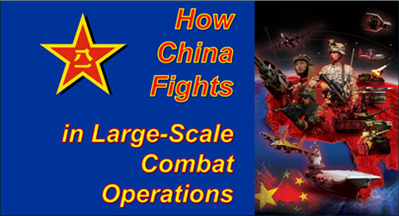[Editor’s Note: The U.S. Army Training and Doctrine Command (TRADOC) released the first in its series of new publications focusing on the United States’ key potential state adversaries – China, Russia, Iran, and North Korea – and how they fight at the operational level of warfare. Beginning with the most capable and formidable of the four, How China Fights in Large-Scale Combat Operations is a comprehensive analysis of the People’s Liberation Army’s (PLA’s) modern operational strategy and capabilities.
 The publication describes China’s military philosophy, details the structure of the PLA and its Joint Theater Commands, and examines the PLA’s approach to operations across all domains, its critical capabilities, and specifically addresses the role of ground forces in Large-Scale Combat Operations. It concludes with two ground force-focused vignettes: an island seizure operation and an island defense. This paper offers the U.S. Army and Joint force an effective starting point for visualizing the potential fight in the Indo-Pacific.
The publication describes China’s military philosophy, details the structure of the PLA and its Joint Theater Commands, and examines the PLA’s approach to operations across all domains, its critical capabilities, and specifically addresses the role of ground forces in Large-Scale Combat Operations. It concludes with two ground force-focused vignettes: an island seizure operation and an island defense. This paper offers the U.S. Army and Joint force an effective starting point for visualizing the potential fight in the Indo-Pacific.
TRADOC G-2 will release the next paper in the series — How Russia Fights in Large-Scale Combat Operation — in July 2025, to be followed by subsequent publications focusing on Iran and North Korea. Stay tuned to the Mad Scientist Laboratory for more information regarding these publications. In the meantime, check out today’s post excerpting the Foreword and Executive Summary from How China Fights in Large-Scale Combat Operations — Enjoy!]
Foreword
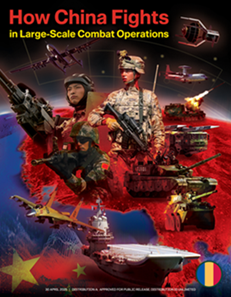 As the Deputy Chief of Staff, G-2 for the U.S. Army’s Training and Doctrine Command (TRADOC), I am pleased to introduce this timely paper, How China Fights in Large-Scale Combat Operations. This will be the first of a series of papers focusing on our key potential adversaries—China, Russia, Iran, and North Korea—and we chose to start with the most capable and formidable of the four. In an article I wrote for Military Review, I argue that large-scale combat operations (LSCO) will be won and lost at the operational level of warfare. Understanding how China fights at the operational level is the first step in ensuring that the Army will be prepared for any conflict in the Indo-Pacific theater. It is my hope that this paper fills a key gap in our understanding of how the Chinese PLA approaches warfare.
As the Deputy Chief of Staff, G-2 for the U.S. Army’s Training and Doctrine Command (TRADOC), I am pleased to introduce this timely paper, How China Fights in Large-Scale Combat Operations. This will be the first of a series of papers focusing on our key potential adversaries—China, Russia, Iran, and North Korea—and we chose to start with the most capable and formidable of the four. In an article I wrote for Military Review, I argue that large-scale combat operations (LSCO) will be won and lost at the operational level of warfare. Understanding how China fights at the operational level is the first step in ensuring that the Army will be prepared for any conflict in the Indo-Pacific theater. It is my hope that this paper fills a key gap in our understanding of how the Chinese PLA approaches warfare.
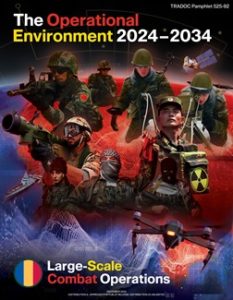 This document builds upon two seminal TRADOC G-2 publications. The first is TRADOC Pamphlet 525-92, The Operational Environment 2024-2034: Large-Scale Combat Operations, which addresses 12 key conditions we assess are present in LSCO and adds another five implications for the U.S. Army when contemplating LSCO. The second is Army Techniques Publication 7-100.3, Chinese Tactics, which describes China’s military strategy, operational concepts, and the likely
This document builds upon two seminal TRADOC G-2 publications. The first is TRADOC Pamphlet 525-92, The Operational Environment 2024-2034: Large-Scale Combat Operations, which addresses 12 key conditions we assess are present in LSCO and adds another five implications for the U.S. Army when contemplating LSCO. The second is Army Techniques Publication 7-100.3, Chinese Tactics, which describes China’s military strategy, operational concepts, and the likely 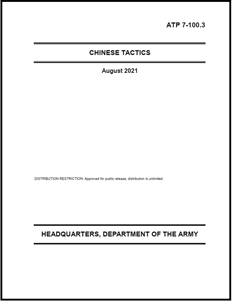 characteristics of future PLA operations. This new paper sheds light on how the Chinese Communist Party views its security environment and how this perception shapes the PLA’s approach to warfighting, particularly its emphasis on “active defense” and “systems confrontation.” The insights presented here are not merely academic; they are essential for informing our training methodologies and force development initiatives.
characteristics of future PLA operations. This new paper sheds light on how the Chinese Communist Party views its security environment and how this perception shapes the PLA’s approach to warfighting, particularly its emphasis on “active defense” and “systems confrontation.” The insights presented here are not merely academic; they are essential for informing our training methodologies and force development initiatives.
 This paper will be disseminated across the Army, the Joint Force, the Intelligence Community, and to our allies and partners to promote a deeper understanding of Chinese military thought and operational practices. It will drive curriculum development at our schools and centers, inform professional military education, support the writing of Army doctrine, and enhance the realism and relevance of U.S. Army training scenarios at Combat Training Centers. By incorporating the PLA’s operational doctrine, tactics, and technological capabilities
This paper will be disseminated across the Army, the Joint Force, the Intelligence Community, and to our allies and partners to promote a deeper understanding of Chinese military thought and operational practices. It will drive curriculum development at our schools and centers, inform professional military education, support the writing of Army doctrine, and enhance the realism and relevance of U.S. Army training scenarios at Combat Training Centers. By incorporating the PLA’s operational doctrine, tactics, and technological capabilities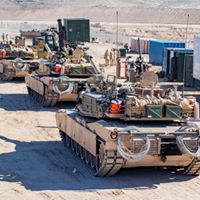 into our opposing force representation, we can also better prepare our Soldiers and leaders for the challenges they would face in a potential conflict in the Indo-Pacific theater. It will help us fulfill our primary mission, which is to know our potential adversaries, and to ensure that our key customers do too.
into our opposing force representation, we can also better prepare our Soldiers and leaders for the challenges they would face in a potential conflict in the Indo-Pacific theater. It will help us fulfill our primary mission, which is to know our potential adversaries, and to ensure that our key customers do too.
I encourage all members of the Army community to engage with this material and consider its implications. If we are to visualize how the Army will participate as part of a Joint, Combined, and interagency team in a future conflict in the Indo-Pacific, then we must begin with an understanding of our potential adversary. This paper offers a fine starting point for that visualization. — Ian Sullivan, Deputy Chief of Staff, G-2, U.S. Army TRADOC
Executive Summary
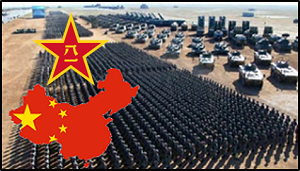 How China Fights in Large-Scale Combat Operations provides a detailed assessment of China’s military strategy, operational concepts, and the anticipated characteristics of the PLA ground forces employed in conflict. As China is designated as the United States’ pacing threat, the U.S. Army must understand how China fights at the operational level to ensure readiness for potential conflicts in the Indo-Pacific theater. This document builds upon foundational material presented in TRADOC Pamphlet 525-92, The Operational Environment 2024-2034: Large-Scale Combat Operations and Army Techniques Publication 7-100.3, Chinese Tactics. TRADOC Pamphlet 525-92 identifies the key Operational Environment conditions that will define LSCO for the foreseeable future, while ATP 7-100.3 provides insights into PLA tactics. Together, these resources offer a comprehensive foundation for understanding the PLA’s approach to conflict and its implications to U.S. Army training and education.
How China Fights in Large-Scale Combat Operations provides a detailed assessment of China’s military strategy, operational concepts, and the anticipated characteristics of the PLA ground forces employed in conflict. As China is designated as the United States’ pacing threat, the U.S. Army must understand how China fights at the operational level to ensure readiness for potential conflicts in the Indo-Pacific theater. This document builds upon foundational material presented in TRADOC Pamphlet 525-92, The Operational Environment 2024-2034: Large-Scale Combat Operations and Army Techniques Publication 7-100.3, Chinese Tactics. TRADOC Pamphlet 525-92 identifies the key Operational Environment conditions that will define LSCO for the foreseeable future, while ATP 7-100.3 provides insights into PLA tactics. Together, these resources offer a comprehensive foundation for understanding the PLA’s approach to conflict and its implications to U.S. Army training and education.
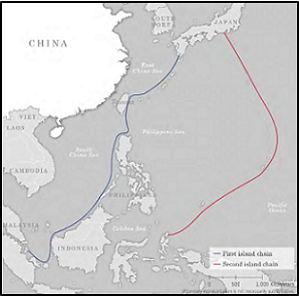
China’s leadership perceives the global security environment as increasingly complex and dangerous, with the United States viewed as a primary adversary. The Chinese Communist Party is focused on safeguarding its core interests, including China’s internal stability and economic development, while expanding its focus to include overseas interests. Taiwan remains a central point of contention, with China rejecting the possibility of foreign interference on this issue. As a result, China’s military strategy is rooted in ‘active defense,’ combining a strategically defensive posture with offensive operational and tactical capabilities. This strategy has resulted in power projection beyond China’s borders, sophisticated anti-access/area-denial capabilities, and other modernization initiatives designed to counter potential interference with its strategic objectives.
In LSCO, China would employ a whole-of-nation approach, integrating military and civilian capabilities to secure its national interests. This approach would feature operations characterized by joint multidomain integration, prioritization of information dominance, and preparation for potentially protracted conflicts. Central to this strategy is ‘systems confrontation,’ where the PLA will leverage its offensive capabilities to paralyze enemy systems across multiple domains. Systems confrontation focuses on targeting interconnected systems—such as command and control, intelligence networks, logistics functions, information systems, and fire-support systems—to neutralize an adversary’s ability to wage war effectively.
China’s emphasis on all-domain warfare underscores its focus on joint multidomain integration and information dominance. The PLA leverages advanced technologies such as artificial intelligence, cyber capabilities, and electronic warfare to achieve decisive victories by exploiting vulnerabilities in enemy systems through precision strikes coordinated across services and domains. This concept is embodied in Multidomain Precision Warfare, the PLA’s core operational concept that integrates operations across all domains to fuse information from all services and launch effects against identified enemy vulnerabilities.
 Anticipating foreign intervention in the Pacific theater, China has developed a comprehensive joint counter-intervention complex aimed at deterring, delaying, and defeating enemy forces before they can arrive in theater at full strength. This campaign involves information operations to disrupt enemy decision-making processes, air and sea dominance efforts to control critical theaters, and joint firepower strikes targeting deployment routes and logistics hubs. PLA ground forces will play an integral role in these campaigns through amphibious assaults, airborne maneuvers, strategic defenses, and counterattacks—all fully integrated into joint operations.
Anticipating foreign intervention in the Pacific theater, China has developed a comprehensive joint counter-intervention complex aimed at deterring, delaying, and defeating enemy forces before they can arrive in theater at full strength. This campaign involves information operations to disrupt enemy decision-making processes, air and sea dominance efforts to control critical theaters, and joint firepower strikes targeting deployment routes and logistics hubs. PLA ground forces will play an integral role in these campaigns through amphibious assaults, airborne maneuvers, strategic defenses, and counterattacks—all fully integrated into joint operations.
 Ground forces, which are often underestimated in discussions about Pacific conflicts dominated by air and naval operations, play a critical role in countering China’s strategies. The PLA’s reliance on ground forces for amphibious assaults, airborne operations, and strategic counterattacks demonstrates their integral role in achieving operational objectives. Similarly, U.S. ground forces are essential for securing key terrain, enabling joint operations, and disrupting adversary systems in contested environments. As the Indo-Pacific theater presents unique challenges due to its geography and the multidomain nature of modern warfare, the U.S. Army must ensure its ground forces are prepared to operate effectively alongside other components of the Joint Force. This preparation is vital not only for deterring aggression but also for ensuring victory in any potential conflict with China.
Ground forces, which are often underestimated in discussions about Pacific conflicts dominated by air and naval operations, play a critical role in countering China’s strategies. The PLA’s reliance on ground forces for amphibious assaults, airborne operations, and strategic counterattacks demonstrates their integral role in achieving operational objectives. Similarly, U.S. ground forces are essential for securing key terrain, enabling joint operations, and disrupting adversary systems in contested environments. As the Indo-Pacific theater presents unique challenges due to its geography and the multidomain nature of modern warfare, the U.S. Army must ensure its ground forces are prepared to operate effectively alongside other components of the Joint Force. This preparation is vital not only for deterring aggression but also for ensuring victory in any potential conflict with China.
If you enjoyed this post, check out the comprehensive How China Fights in Large-Scale Combat Operations
Review the TRADOC Pamphlet 525-92, The Operational Environment 2024-2034: Large-Scale Combat Operations
Explore the TRADOC G-2‘s Operational Environment Enterprise web page, brimming with authoritative information on the Operational Environment and how our adversaries fight, including:
Our China Landing Zone, full of information regarding our pacing challenge, including ATP 7-100.3, Chinese Tactics, BiteSize China weekly topics, and the People’s Liberation Army Ground Forces Quick Reference Guide.
Our Russia Landing Zone, including the BiteSize Russia weekly topics. If you have a CAC, you’ll be especially interested in reviewing our weekly RUS-UKR Conflict Running Estimates and associated Narratives, capturing what we learned about the contemporary Russian way of war in Ukraine over the past two years and the ramifications for U.S. Army modernization across DOTMLPF-P.
Our Iran Landing Zone, including the Iran Quick Reference Guide and the Iran Passive Defense Manual (both require a CAC to access).
Our Running Estimates SharePoint site (also requires a CAC to access) — documenting what we’re learning about the evolving OE. Contains our monthly OE Running Estimates, associated Narratives, and the quarterly OE Assessment TRADOC Intelligence Posts (TIPs).
Then review the following China-related Mad Scientist Laboratory content:
“No Option is Excluded” — Using Wargaming to Envision a Chinese Assault on Taiwan, Three Dates, Three Windows, and All of DOTMLPF-P, China and Russia: Achieving Decision Dominance and Information Advantage, and Seven Reflections of a “Red Commander” — Lessons Learned Playing the Adversary in DoD Wargames, by Ian Sullivan
The Most Consequential Adversaries and associated podcast, with GEN Charles A. Flynn (USA-Ret.)
Volatility in the Pacific: China, Resilience, and the Human Dimension and associated podcast, with General Robert Brown (USA-Ret.)
How China Fights and associated podcast
Fait Accompli: China’s Non-War Military Operations (NWMO) and Taiwan, by SGT Michael A. Cappelli II
Operation Northeast Monsoon: The Reunification of Taiwan, by Sherman Barto
Flash-Mob Warfare: Whispers in the Digital Sandstorm (Parts 1 and 2), by Dr. Robert E. Smith
China’s PLA Modernization through the DOTMLPF-P Lens, by Dr. Jacob Barton
The PLA and UAVs – Automating the Battlefield and Enhancing Training
A Chinese Perspective on Future Urban Unmanned Operations
China: “New Concepts” in Unmanned Combat and Cyber and Electronic Warfare
The PLA: Close Combat in the Information Age and the “Blade of Victory”
China: Building Regional Hegemony
Intelligentization and the PLA’s Strategic Support Force, by Col (s) Dorian Hatcher
“Intelligentization” and a Chinese Vision of Future War
>>>>Announcement: You are cordially invited to the Army Mad Scientist Initiative’s “Global Perspectives on the OE: Indo-Pacific” Virtual Event on the 22nd of May 2025. Partnering with our U.S. Army TRADOC Foreign Liaison Officers, this virtual event will explore our Allies and Partners’ perspectives on the Operational Environment, featuring prominent subject matter experts from some of our Allies and Partners in the Indo-Pacific theater to establish an open dialogue on their perspectives regarding the Operational Environment. The event will be held from 6:00pm EDT to 11:30pm EDT. Register to attend this event at the Eventbrite link here
Once registered, you will receive a follow-up email with the link to the virtual event. A final agenda will be distributed to those who are registered in the coming weeks.
You must be registered in Eventbrite to receive a virtual event link! Stay tuned to all Army Mad Scientist social media and the Mad Scientist Laboratory for further updates!
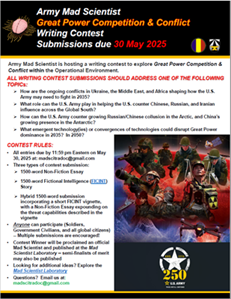 >>>>Reminder: Army Mad Scientist wants to crowdsource your thoughts on Great Power Competition & Conflict — check out the flyer describing our latest writing contest.
>>>>Reminder: Army Mad Scientist wants to crowdsource your thoughts on Great Power Competition & Conflict — check out the flyer describing our latest writing contest.
All entries must address one of the following writing prompts:
How are the ongoing conflicts in Ukraine, the Middle East, and Africa shaping how the U.S. Army may need to fight in 2035?
What role can the U.S. Army play in helping the U.S. counter Chinese, Russian, and Iranian influence across the Global South?
How can the U.S. Army counter growing Russian/Chinese collusion in the Arctic, and China’s growing presence in the Antarctic?
What emergent technology(ies) or convergences of technologies could disrupt Great Power dominance in 2035? In 2050?
We are accepting three types of submissions:
-
-
- 1500-word Non-Fiction Essay
-
-
-
- 1500-word Fictional Intelligence (FICINT) Story
-
-
-
- Hybrid 1500-word submission incorporating a short FICINT vignette, with a Non-Fiction Essay expounding on the threat capabilities described in the vignette
-
Anyone can participate (Soldiers, Government Civilians, and all global citizens) — Multiple submissions are encouraged!
All entries are due NLT 11:59 pm Eastern on May 30, 2025 at: madscitradoc@gmail.com
Click here for additional information on this contest — we look forward to your participation!

